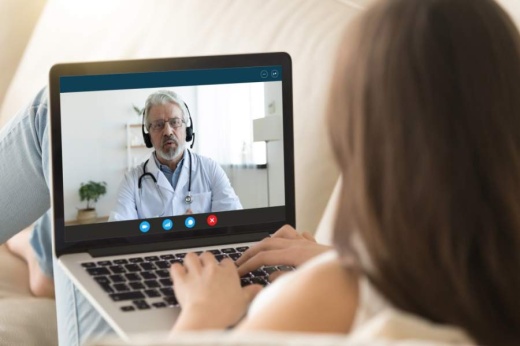Through partnerships with the Texas Department of Criminal Justice and the Texas Juvenile Justice Department, UTMB Health physicians provide virtual medical, dental and mental health services for adult and juvenile inmates.
Owen Murray, vice president of offender health services at UTMB, said the system cares for about 80% of the state’s prison populations. Murray said UTMB Health pioneered the telehealth movement, which was born from a need to limit transportation costs to more than 80 correctional and prison facilities across the state.
In the mid-2000s, UTMB Health expanded its telehealth service beyond Texas’ prison system, providing primary care and mental health services virtually to the general public. Now of its almost 160,000 telehealth encounters annually, primary care appointments account for roughly 60,000, mental health totals 60,000, and the remaining 40,000 are inmates from across the state.
Community Impact Newspaper spoke with Murray on how UTMB Health provides telehealth services and how other facilities can lean into this service during the coronavirus. This interview has been edited for length and clarity.
Are there any challenges that come along with telemedicine, and how has UTMB overcome those challenges?
Obviously, there are some limitations: I can't feel a knee; I can't palpate a belly; I can’t do a rectal exam. But if you look at the gamut of care, especially in the prison system, 70%-80% of it is all things we can do through telemedicine. ... If I can't do something, we do have unit providers there that will be on-site. ... We've also learned to train nursing staff to be able to do some of those evaluations. Ultimately, I can't lay hands on the patient, and so you just need to figure out how to get that part of the exam done in a meaningful way. ... We'll triage our requests for care in a way that we don't put those types of exams in front of a telemed provider. It really comes down to knowing what should be on telemed and what needs to be seen hands on.
How have you seen the need for telemedicine grow in the last two months during the coronavirus?
In the prison system, it hasn't changed our volumes. ... Much like in the free world, if it's not urgent or emergency care, we've been asked not to do that. So actually our numbers have decreased a little bit just because we're trying to minimize movement within the prison facility to be respectful of what's going on with COVID-19.
Our counterparts and colleagues on [Galveston] island have expanded their telemedicine to be able to reach out to patients and keep patients within care. ... All health systems have seen a significant decline in the number of patients coming to their clinic, because it was really supposed to be only urgent or emergent, but they still wanted to maintain ongoing care. So they switched to telemedicine, which allowed them to see patients but not have to bring them into a clinic and create infection control risk.
How do you see telemedicine fitting into the future of medicine?
I think with the advent of technology and the ability to [connect] with Zoom and Skype ... people can get online, and you can see a doc face to face. You can get some care done [and] certainly care for some chronic diseases where it's really more discussion therapy and less relying on examination. ... Those types of things can move very efficiently to telemedicine, and we would have the data that say that that's true. ... Being able to do both subspecialty care, mental health care as well as primary care, telemedicine is an excellent vehicle. Is it a panacea, and is it something that can replace hands-on care? No, but it certainly has this role. As we evolve into needing and requiring more care in our country, telemedicine is a great vehicle to expand access to everybody.
Do you have any tips or suggestions for other physicians or hospitals that are beginning to implement telemedicine?
You have to get out there and do it. We started with the idea that we were just going to do subspecialty care, and our numbers have just mushroomed because we started looking at other areas. ... We do all of our hepatitis C and HIV care over telemedicine; we have pharmacists who run blood center clinics and other clinics from their offices. With technology, once you get in there and you start playing around with it and seeing how it works, then you figure out ways for it to work in your practice. Then ways that can be expanded to make it more convenient for patients but also for the providers as well.
Is there anything you’d like to add specifically on providing care to inmates now?
Obviously, we've had our cases here, but we've followed the [Centers for Disease Control and Prevention] guidelines for correctional [facilities] and for jails and prisons. I will say [Texas Department of Criminal Justice] was an early adopter of those standards, and so I think our mitigation efforts have been exceedingly successful. We've got 145,000 offenders, and in the end we've had probably six or seven facilities that have had most of our infections. We've done a very good job managing those patients’ care within the prison system and then those that needed care, for the most part, have gone to Hospital Galveston. ... We really have done a very good job with our testing and access to testing and ability to—within these prisons—quarantine and restrict movement, quarantine patients who are certainly positive for the virus but also quarantine those that have come in contact. I think all the mitigation effort steps the department has taken has been exceedingly helpful.





